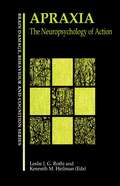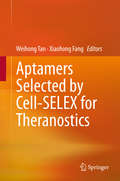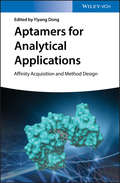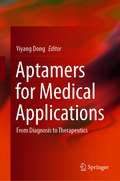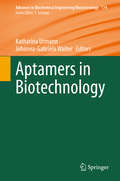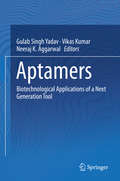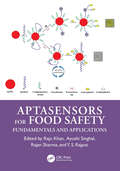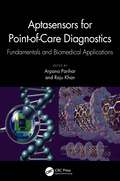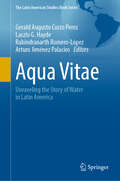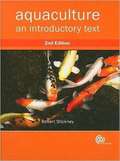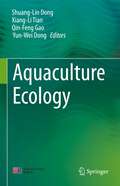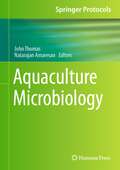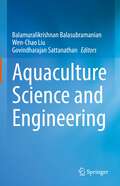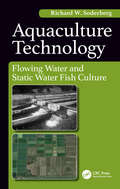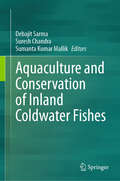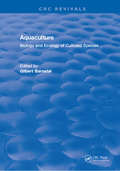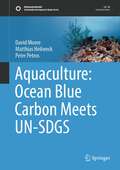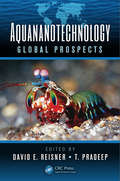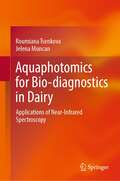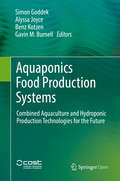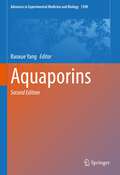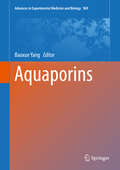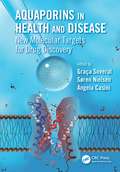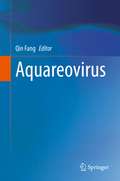- Table View
- List View
Apraxia: The Neuropsychology of Action (Brain, Behaviour and Cognition)
by Kenneth M. Heilman Leslie J. Gonzalez RothiThe purpose of this book is to provide the reader with a perspective on apraxia that considers a link between the pathology of apraxia and normal motor skill. In addition, it is the intention of the authors to provide information that is theoretically interesting as well as clinically applicable. The book is a collection of papers by various authors working in the area of apraxia, almost exclusively with limb aparaxia specifically. Beginning with Hugo Liepman's work of the late 19th century, a cognitive neuropsychological model of limb apraxia is reviewed, the use of new technologies that are informative about the mechanisms of limb praxis are discussed, and issues related to research as well as clinical assessment/management of the disorder are provided. While acquired limb apraxia is the focus of the book, there are also chapters on handedness, developmental apraxia of speech, and disorders of handwriting.
Aptamers Selected by Cell-SELEX for Theranostics
by Weihong Tan Xiaohong FangThis edited volume describes cell-SELEX as the fundamental tool used to generate aptamer molecules for a wide range of applications in molecular medicine, bioanalysis and chemical biology. Easily integrated into the natural heterogeneous cell matrix, aptamers can be effectively used in theranostics, bioanalysis, environment detection and biomedical studies. The book gathers reviews that reflect the latest advances in the field of aptamers and consists in fourteen chapters demonstrating essential examples of these aptamers and aptamer-nanomaterial assemblies, depending on the types of applications and biological systems. It also includes a separate chapter on the utilization of aptamers in real clinics and what will be required to achieve this significant goal. The book will be both appealing and useful to a broad audience, including biologists, bioscientists, and clinicians whose interests range from chemistry and biomedical engineering to cell and molecular biology and biotechnology. Weihong Tan is a Distinguished Professor of Chemistry and Biomedical Engineering at Hunan University, China and also a University of Florida Distinguished Professor and V. T. and Louis Jackson Professor of Chemistry at the University of Florida, USA. Xiaohong Fang is a Professor at the Institute of Chemistry, Chinese Academy of Sciences, China.
Aptamers for Analytical Applications: Affinity Acquisition and Method Design
by Yiyang DongAn essential guide that puts the focus on method developments and applications in aptamers In recent years, aptamer-based systems have been developed for a wide-range of analytical and medical applications. Aptamers for Analytical Applications offers an introduction to the topic, outlines the common protocols for aptamer synthesis, as well as providing information on the different optimization strategies that can obtain higher affinities to target molecules. The contributors?noted experts on the topic?provide an in-depth review of the characterization of aptamer-target molecule interaction and immobilization strategies and discuss the developments of methods for all the relevant applications. The book outlines different schemes to efficiently immobilize aptamers on substrates as well as summarizing the characterization methods for aptamer-ligand complexes. In addition, aptamer-based colorimetric, enzyme-linked, fluorescent, electrochemical, lateral flow and non-labeling analytical methods are presented. The book also reflects state-of-the-art and emerging applications of aptamer-based methods. This important resource: -Provides a guide to aptamers which provide highly specific and sensitive molecular recognition, with affinities in the range of antibodies and are much cheaper to produce -Offers a discussion of the analytical method developments and improvements with established systems and beyond -Offers a comprehensive guide to all the relevant application areas -Presents an authoritative book from contributors who are noted experts in the field Written for analytical chemists, biochemists, analytical researchers, Aptamers for Analytical Applications is a comprehensive book that adopts a methodological point of view to the important aspects of aptamer generation and modification with a strong emphasis on method developments for relevant applications.
Aptamers for Medical Applications: From Diagnosis to Therapeutics
by Yiyang DongThis book outlines comprehensively the main medical uses of aptamers, from diagnosis to therapeutics in fourteen chapters. Pioneering topics covered include aptamer pharmaceuticals, aptamers for malign tumors, aptamers for personalized therapeutics and aptamers for point-of-care testing. The book offers an essential guide for medical scientists interested in developing aptamer-based schemes for better theranostics. It is therefore of interest for not only academic researchers, but also practitioners and medical researchers in various fields of medical science, medical research and bio-analytical chemistry.
Aptamers in Biotechnology (Advances in Biochemical Engineering/Biotechnology #174)
by Johanna-Gabriela Walter Katharina UrmannThis book reviews the development, characterization and applications of aptamers in different areas of biotechnology ranging from therapeutics to diagnostics and protein purification. Hailed as chemical antibodies, these single-stranded nucleic acid receptors were predicted to supersede antibodies in traditional assays, such as ELISA, within a short time. While this has yet to happen, readers will find in this book a deep insight into the progress of aptamer technology and a critical discussion about the limitations that need to be overcome in order to find wider acceptance and use outside of the still relatively small aptamer-community. This book covers all aspects of aptamer generation and application for the aptamer-experienced reader and curious novice alike, with the addition of an industry perspective on the future of aptamer-use in biotechnology.
Aptamers: Biotechnological Applications of a Next Generation Tool
by Vikas Kumar Gulab Singh Yadav Neeraj K. AggarwalThe book discusses the basics of aptamers and the advent of aptamer-based technology in recent times. The book covers the diverse applications of aptamers, such as in detection of animal and plant pathogens, disease diagnosis and therapeutics, environmental contamination detection etc. Besides these applications, the book also describes the use of these synthetic or modified DNA, as drug delivery vehicles.The different chapters describe how the binding capacity and specificity of aptamers can be exploited in various ways. The book also discusses how these attributes of aptamers can outdo the antibody technology in biomedical and diagnostic solutions. This crisp and concise book gives the readers an insight into the most recent biotechnological applications of aptamers.
Aptasensors for Food Safety: Fundamentals and Applications
by Rajan Sharma Raju Khan Ayushi Singhal Y. S RajputThis reference book provides updated knowledge on fundamentals and applications of aptasensorsin food science. It discusses aptamer selection strategies including Systematic Evolution of Ligandsthrough EXponential enrichment (SELEX), Capture SELEX, Cell SELEX, and GO SELEX strategiesfor aptasensor design involving well-studied and newly emerged nanomaterials, food analysisfocusing on its safety, aptasensing techniques relevant to detection of food pathogens, pesticides,veterinary drug residues, toxins, heavy metals, allergens, and future perspectives of aptamers infood science and technology. The book focuses on recent developments in aptasensors and their usein detection of contaminants in food. The book is an excellent resource for R&D organizationsdedicated to the development of biosensors in general and aptasensors in particular for the detectionof environmental contaminants in the food supply chain. Also, the contents of the book willbe useful to researchers, postgraduate students, analytical chemists, food scientists, and regulatoryauthorities.
Aptasensors for Point-of-Care Diagnostics: Fundamentals and Biomedical Applications
by Arpana PariharThe design and fabrication of aptamer-based biosensors for point-of-care testing of disease diagnostic and prognostic is an upthrust and interdisciplinary area of research. This book covers the design and development of novel cost-effective aptamer-based biosensors for disease diagnostic and prognostic including an understanding of health care management in terms of timely updates of disease situations in a particular geographical area. It also discusses the scaling up and market trend of aptamer-based devices for extension of research from lab to market, and end users. Features: Explains the design and fabrication of aptasensors-based diagnostic devices. Includes novel approaches and comprehensive technology overview for diagnosis management towards early-stage detection of various biomarkers associated with several health conditions. Demonstrates possible benefits of combined diagnostics and therapeutic possibilities using aptamer-based point-of-care technologies devices. Discusses emerging implications and recent advances of biosensing platforms for designing and developing aptamer-based point-of-care testing (POCT) devices. Explores aptamer-based approach to develop advanced platforms for medical applications and open arena for state-of-the-art future research. This book is aimed at researchers and graduate students in biomedical engineering, diagnostics, nanobiotechnology, and materials science.
Apun: The Arctic Snow
by Matthew SturmThere are some twenty-five words for “snow” in the Inupiaq language. Each word denotes a different kind of snow—fresh powder snow, hard pack, soft snow, very wet snow, or just snow. Such fine distinction is reasonable, for over the centuries, Natives of the Arctic have had to rely on their knowledge of the snow to survive. Now Matthew Sturm has prepared an educational children’s book designed to teach a new generation of Arctic residents the importance of Arctic snow cover. Fully illustrated to demonstrate the cycle of the snow cover, Apun covers each phase of the “snow year.” Geared towards grades 3–4, this is a must read for elementary science classes.
Aqua Vitae: Unraveling the Story of Water in Latin America (The Latin American Studies Book Series)
by Gerald Augusto Corzo Perez Laszlo G. Hayde Rabindranarth Romero-López Arturo Jiménez PalaciosThis comprehensive book presents an analytical journey through the relationship between water and Latin American societies, offering an engineering perspective on historical water resource utilization. The book unravels the integral role water has played in the cultural, technological, and socio-economic development of the region, providing a foundational reference for engineers, academics, and researchers. The book's exploration into water's perception and usage throughout history provides key insights into how human activity has impacted water resources and vice versa. It presents a meticulous examination of water as both a natural and cultural phenomenon, identifying its essential role in sustaining life and ecosystems, as well as its potential for causing devastation through disease and natural disasters. We delve into the complexities of water's role in society, illustrating how it is woven into the fabric of everyday life, religious ceremonies, and global events. The book also underscores the varying significance and implications of water across different regions within Latin America. The narrative unfolds across three major sections: Technology, Water Management, and Socio-Cultural-Economical Impact. The 'Technology' section examines the evolution of water-related technologies and their significant socio-economic implications. The 'Water Management' part offers a holistic perspective on water resource management practices, both historical and contemporary. The final section delves into the societal implications of water use, including conflicts arising from political and economic decisions related to this crucial resource. Designed for engineers, environmental scientists, and policy-makers, this book provides a unique blend of historical context, technical knowledge, and socio-cultural insights. It offers an invaluable resource for those seeking to understand the interplay between engineering practices, water resources, and societal developments in Latin America. It serves as a springboard for further research and informed decision-making in water resource management and policy, fostering a greater understanding of the myriad ways in which water influences and is influenced by human activity.
Aquaculture
by Robert R StickneyProviding a broad and readable overview of the subject, this updated second edition of Aquaculture: An Introductory Text covers issues associated with sustainable aquaculture development, culture systems, hatchery methods, nutrition and feeding of aquaculture species, reproductive strategies, harvesting, and many other topics. While its main focus is on the culture of fish, molluscs, and crustaceans for food, the book also covers other forms of aquaculture, such as the production of seaweeds, recreational fish and ornamental species, and live foods such as algae and rotifers that are used to feed larval shrimp and marine fish. Printed in a new, larger format and illustrated with many photos and diagrams, this will be an essential resource for undergraduate students of aquaculture and related topics. The scope is global and much of the information is based on first-hand experiences of the author.
Aquaculture Ecology
by Shuang-Lin Dong Xiang-Li Tian Qin-Feng Gao Yun-Wei DongThis book introduces aquaculture ecology as a science of the interaction between commercial aquatic organisms as well as their farming activities and the environment, including the rationales of building and management of aquaculture systems. This book covers productivity and carrying capacity, effects of cyclical fluctuation of environmental factors on aquatic organisms, biological control of water quality, structural optimization of aquaculture systems and ecological prevention of disease. In the last chapter, aquaculture production systems are introduced from multiple perspectives.This book has been designed to provide a stimulating and informative text for researchers in aquaculture, fisheries as well as hydrobiology.
Aquaculture Microbiology (Springer Protocols Handbooks)
by John Thomas Natarajan AmaresanThis volume details techniques involved to study aquatic pathogens that cause infections, especially in fish. Chapters guide readers through a wide range of basic and advanced methods, viral and fungal pathogens, probiotic bacteria, treatment of pathogens using seaweed extract, medicinal plant extracts, and actinomycetes. Authoritative and cutting-edge, Aquaculture Microbiology aims to be a useful practical guide to researches to help further their study in this field.
Aquaculture Science and Engineering
by Balamuralikrishnan Balasubramanian Wen-Chao Liu Govindharajan SattanathanThis book is about relevant recent research topics in understanding aquaculture for practical approaches; aquatic science, engineering, feed and nutrition, immunology and health are reviewed. The book includes information on why certain fish strains differ in disease resistance, all the current data on fish cell populations, the regulation of the response by factors, and the major histocompatibility complex are explained in detail. The book contains the chapters on nutrition, feed and feed additives, ecology, immunology, microbiology, toxicology, biochemistry, nanotechnology, pharmacology, and biotechnology, among other fields of basic and applied research. Over the past era, scientists have recognized the importance of nutrition in maintaining the health of humans and other animal species, including fish. Humans and other terrestrial animals were the focus of previous research on the links between nutrition, immune response, and disease resistance. However, attempts to conduct similar studies using fish have met with limited success in the last two decades due to a lack of understanding of the immune response in fish. In most facilities, the animals are kept at relatively high densities, causing stress and disease problems are the challenges that we face today and this book opens up the exciting new area of research to truly understand the relationship between fish genetics and immune reactivity. The aquatic immune system turns out to be a crucial reference as aquatic products are increasingly used as model systems for vertebrate immune systems. This book provides that the research students and scientists with a useful text on the latest knowledge of the aquatic feed and nutrition, immune system, cutting-edge technologies, draws everyone’s attention to the practice of small-scale aquaculture and provides a guide on how to responsibly use the water ecosystem and the steps needed to develop, test and market fish vaccines. The chapters will serve as introductions to these fields and up-to-date reviews of recent research advances. This book is intended for a wide range of readers, including nutritionists, disease specialists, feed formulators, students, extension specialists, and farmers, as well as university teachers, graduates and doctoral students in zoology, physiology, aquaculture, and biology in general.
Aquaculture Technology: Flowing Water and Static Water Fish Culture
by Richard Soderberg W.Key features: Takes a quantitative approach to the science of aquaculture Covers the complete landscape of the scientific basis of fish culture Promotes problem solving and critical thinking Includes sample problems at the end of most chapters Guides the reader through the technical considerations of intensive aquaculture, including fish growth rates, hydraulic characteristics of fish rearing units, oxygen consumption rates in relation to oxygen solubility and fish tolerance of hypoxia, and water reconditioning by reaeration and ammonia filtration. Discusses the environmental effects of aquaculture Includes a chapter on hatchery effluent control to meet receiving water discharge criteria Aquaculture Technology: Flowing Water and Static Water Fish Culture is the first book to provide the skills to raise fish in both a flowing water and a static water aquaculture system with a pragmatic and quantitative approach. Following in the tradition of the author’s highly praised book, Flowing Water Fish Culture, this work will stand out as one that makes the reader understand the theory of each type of aquaculture system; it will teach the user "how to think" rather than "what to think" about these systems. The book presents the scientific basis for the controlled husbandry of fish, whether it be in a stream of water or a standing water pool. Part 1, Flowing Water Fish Culture, is a major revision of the author’s initial book and includes greatly expanded coverage of rearing unit design criteria, fish growth and the use of liquid oxygen, hatchery effluent control, and recirculating systems. Part 2, Static Water Fish Culture, presents the scientific basis of fish culture in standing water systems including nutrient and dissolved gas dynamics, pond ecology, effects of fertilization and supplemental feeding, water quality management and representative static water aquacultures. Aquaculture Technology conveys the science in a manner appropriate for use by university students and teachers and others involved in fish production and aquaculture research and development worldwide. It will enable the reader to adapt to changing technologies, markets, and environmental regulations as they occur.
Aquaculture and Conservation of Inland Coldwater Fishes
by Suresh Chandra Debajit Sarma Sumanta Kumar MallikThis book provides the latest information on trans-Himalayan Hindu Kush Region (HKR) fisheries including the Indian Himalayan Region (IHR) as well as the historical context of its sustainable development for improving livelihood and nutritional security. The book serves as an important document to provide knowledge and information about the major concerns of environmental and anthropogenic factors that have impacted the population of certain important fishes in the ecosystem and the strategies and policies required for the conservation of these important groups of fishes, viz., Mahseer, snow trout, minor carp, catfishes, etc. The chapters describe the information to the readers on potential cold water and cool water fish species suitable for large-scale farming and propagation addressing the issues of diseases, nutrigenomics, and nanobiotechnology. This book also addresses the prospects and potential of recreational fishing in India and the scope for its improvement to generate more employment and income citing the success stories and primary information from reputed anglers. Finally, the book also elucidates a comprehensive yet representative description of many challenges associated with inland coldwater- cool water fisheries and aquaculture in HKR, IHR, and its way forward.
Aquaculture: Biology and Ecology of Cultured Species
by Gilbert BarnabeThis unique book introduces the biological and ecological basis of the production process in water, and the biology of cultured species. It bridges the gap between research data and aquaculture techniques, and covers problems arising in aquaculture production, such as filtering molluscs. It also introduced modern aspects of oceanography that are important for understanding the production process. The book starts with a section dedicated to the production of living material and matter in the aquatic environment. It then goes on to explore in detail the biological basis of mollusc, crustacean and fish cultures, and the reproduction and nutrition of bivalve molluscs. Also discussed are the intensive and extensive aquaculture producing processes in fresh and marine waters, and finally the pathology reared animals. Up-to-date data are provided and explained to the student using graphs and copious illustrations. The work is especially orientated toward the student reader and provides a comprehensive and authoritative text on the subject.
Aquaculture: Ocean Blue Carbon Meets UN-SDGS (Sustainable Development Goals Series)
by David Moore Peter Petros Matthias HeilweckThis book presents a solutions based approach to reducing and removing CO2 from the atmosphere transforming it into solid (crystalline) CaCO3 through the ability of marine organisms such as molluscs, crustacea, corals, and coccolithophore algae. The overwhelming advantage of this approach is that it promises enhanced climate mitigation in comparison to planting forests, industrial/engineering carbon capture and storage process. It also provides a sustainable food resource. Furthermore, it would improve the ocean's biodiversity at the same time as the excess atmospheric CO2 released by our use of fossil fuels is returned to the place it belongs - as a present day fossil, safely out of the atmosphere to the distant future. If the level of finance and global effort that are readily foreseen for forest management and flue gas treatments were applied to expansion of global shellfish cultivation, curative amounts of carbon dioxide could be permanently removed from the atmosphere within a few decades. The concept presented in this book could have a profound influence on the life of the planet.
Aquananotechnology: Global Prospects
by T. Pradeep David E. ReisnerThe world's fresh water supplies are dwindling rapidly-even wastewater is now considered an asset. By 2025, most of the world's population will be facing serious water stresses and shortages. Aquananotechnology: Global Prospects breaks new ground with its informative and innovative introduction of the application of nanotechnology to the remediatio
Aquaphotomics for Bio-diagnostics in Dairy: Applications of Near-Infrared Spectroscopy
by Roumiana Tsenkova Jelena MuncanThis book is the result of more than 20 years of experience in working with near-infrared spectroscopy for raw milk analysis. The totality of this work presents extensive possibilities for milk spectral measurements that can be carried out in dairy. Moving beyond the standard milk components such as fat, protein, or lactose, this book presents near-infrared spectroscopy as a method that can also be used in disease diagnostics. The measurements and experimental results presented here are all based on the utilization of usually neglected near-infrared regions—regions with strong absorbance of water. The author has found the water – light interaction discussed to be an immensely rich source of information, not only on milk composition but also on the physiological status of the animals involved. A special section of the book is dedicated to exploration of potential interfering factors that may influence the analysis and contribute to the robustness of the models. The research described in this book served as a basis for the development of the novel discipline aquaphotomics and is of interest to anyone working in this field.
Aquaponics Food Production Systems: Combined Aquaculture and Hydroponic Production Technologies for the Future
by Simon Goddek Alyssa Joyce Benz Kotzen Gavin M. BurnellThis open access book, written by world experts in aquaponics and related technologies, provides the authoritative and comprehensive overview of the key aquaculture and hydroponic and other integrated systems, socio-economic and environmental aspects. Aquaponic systems, which combine aquaculture and vegetable food production offer alternative technology solutions for a world that is increasingly under stress through population growth, urbanisation, water shortages, land and soil degradation, environmental pollution, world hunger and climate change.
Aquaporins (Advances in Experimental Medicine and Biology #1398)
by Baoxue YangThis book provides a state-of-the-art report on our current understanding of aquaporins and the future direction of the field. Aquaporins (AQPs) are a group of water-channel proteins that are specifically permeable to water and other small molecules, such as glycerol and urea. To date thirteen water-channel proteins (AQP0 – AQP12) have been cloned and the mechanisms and physiological functions of water transport across biological membranes have long been the subject of interest. Recent advances in the molecular biology and physiology of water transport have yielded new insights into how and why water moves across cell membranes, and studies on aquaporin knockout mouse models suggest that aquaporins are involved in the development of some diseases and they may be useful targets of research into selective-inhibitor drugs. By focusing on the advances made over the last 30 years in the biophysics, genetics, protein structure, molecular biology, physiology, pathophysiology and pharmacology of aquaporins in mammalian cell membranes, this book provides novel insights into further mechanisms and the physiological significance of water and some small molecule transport in mammals in order to stimulate further research in new directions.In the second version, fourteen chapters will be updated base on the most recent research articles. Ten new chapters will be added.
Aquaporins (Advances in Experimental Medicine and Biology #969)
by Baoxue YangThis book provides a state-of-the-art report on our current understanding of aquaporins and the future direction of the field. Aquaporins (AQPs) are a group of water-channel proteins that are specifically permeable to water and other small molecules, such as glycerol and urea. To date thirteen water-channel proteins (AQP0 - AQP12) have been cloned and the mechanisms and physiological functions of water transport across biological membranes have long been the subject of interest. Recent advances in the molecular biology and physiology of water transport have yielded new insights into how and why water moves across cell membranes, and studies on aquaporin knockout mouse models suggest that aquaporins are involved in the development of some diseases and they may be useful targets of research into selective-inhibitor drugs. By focusing on the advances made over the last 20 years in the biophysics, genetics, protein structure, molecular biology, physiology, pathophysiology and pharmacology of aquaporins in mammalian cell membranes, this book provides novel insights into further mechanisms and the physiological significance of water and some small molecule transport in mammals in order to stimulate further research in new directions.
Aquaporins in Health and Disease: New Molecular Targets for Drug Discovery
by Angela Casini Graça Soveral S0ren NielsenSince the discovery of Aquaporin-1 (AQP1) as a water channel, many studies have revealed the importance of aquaporins in mammalian physiology and pathophysiology as well as plant and microbial biology. The studies have also shown aquaporins as potential drug targets and targets for improving crop properties.Written by an international group of contributors at the forefront of the field, Aquaporins in Health and Disease: New Molecular Targets for Drug Discovery presents the latest research advances in aquaporins and other major intrinsic protein (MIP) channels. The first section of the book describes the general concepts of aquaporin channel function, genomic research, structure-function analysis of aquaporins and glycerol facilitators, and regulation by gating and trafficking, including yeast aquaporin regulation and function. The second section discusses the physiological and pathophysiological roles of aquaporins in humans and microbes. The final section covers the development of inhibitors of aquaporin function. The book’s epilogue offers future perspectives and directions, mainly in the area of aquaporin-based diagnostics and therapeutics.Stimulating future research on this important protein family, this book facilitates a paradigm shift in the understanding and roles of aquaporin membrane proteins in all biological settings. It encourages scientists to develop novel approaches for the treatment of human diseases based on aquaporin function or dysfunction.
Aquareovirus
by Qin FangAquareoviruses cause infection in bony fish and shellfish and thus, constitute a significant threat to aquaculture industries worldwide. Aquareoviruses, belonging to the family Reoviridae, have genomes consisting of 11 segments of double-stranded RNA contained within a core (T = 1) surrounded by a double-layered icosahedral capsid with a T = 13 symmetry in general. These viruses not only physically resemble mammalian orthoreoviruses, but also show the highest amino acid identity. More than hundred aquareoviruses have been isolated from both saline water and freshwater origins; however, literary sources elucidating aquareovirus biology are very limited. Given the increasing pace of discovery, it is imperative to make a clear, systematic filing of key aspects of aquareoviruses. Therefore, the aim of writing this book is to provide insights into the molecular mechanisms of evolution, pathogenesis, and host response in aquareovirus infection. This book offers a state-of-the-art report on recent discoveries concerning the aquareovirus genome evolution, gene encoded protein functions, and pathogenesis by comparison with its sister genus Orthoreovirus, including avian and mammalian reoviruses. It mainly focuses on advances made over the past 30 years in research on the general and molecular biology, protein structure and function, infection and replication, epidemiology and diagnosis, immunological prevention and medical treatment, and host antiviral immunity against aquareovirus infection. This book will help curious graduate students or interested researchers acquire an overall picture of aquareovirus infection and pathogenesis, as well as yield benefits in fisheries to better prevent and control diseases caused by aquareovirus infection.
